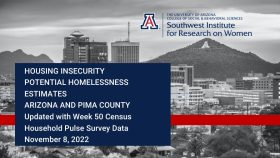
The University of Arizona Southwest Institute for Research on Women has released its thirty-eighth update to its report on Housing Insecurity Indicators and Potential Homelessness Estimates for Arizona and Pima County. This report measures current housing insecurity with newer census data. Without further analysis the causes of this locally are unclear, but the prime suspects are rising rents and the lingering aftermaths of the pandemic for the household budgets of lower-income households (via death, illness, and changes in employment and caretaking responsibilities).
Since the last census wave, there are points of significant concern. Those include:
- In the previous survey wave, collected September 14th-26th 2022, the proportion of non-current renters grew to 13.2% (up from 9.2% in early August 2022).
- In the most recent survey, conducted October 5th-17th 2022, this proportion continued to rise modestly to 14.5%.
- An alarmingly large number of Arizona renters – an estimated 31.6k households statewide – view eviction as imminent.
- The vast majority of Arizona renters who are behind on their rent, 87%, were only 1 or 2 months behind on their payments. This may explain, in part, why 81% of non-current renters in Arizona have not applied for rental assistance.
- 6.2% Mortgage holders reported being not current on mortgage payments (up from 2.8% in the previous survey) and of those that are not current 79% see a foreclosure in the next two months as either “not very likely” or “not likely at all”.
The most recent update to the report also includes many indicators that have seen some improvement.
- Tucson rent prices appear to be slowing their rate of increase substantially in recent months.
- Likely a downstream consequence of recent interest rate hikes by the Federal Reserve, rent increases are slowing down.
- This does not erase the 34-39% increases in average and median rents experienced over the past two years. Statewide 66% of Arizona renters reported an increase in their monthly rent in the last year and 44% reported an increase of $100 or more. Most renters have been directly impacted by recent increases in rent prices in Arizona.
- Racial/ethnic disparities in financial strain have increased in measures of households not being current on rental payments and experiencing difficulty meeting spending needs.
- Individuals (nationwide) reporting either a lot of difficulty or no ability to see or concentrate are disproportionately likely to report being behind on rent payments.
- It appears that members of historically marginalized groups (especially people living with disabilities) are not benefiting from the improving economy as quickly on average as other demographic groups.
- Generally, a falling unemployment rate is usually associated with reductions in eviction filings, but here we observe rising eviction filings in the context of very low and stable unemployment.
